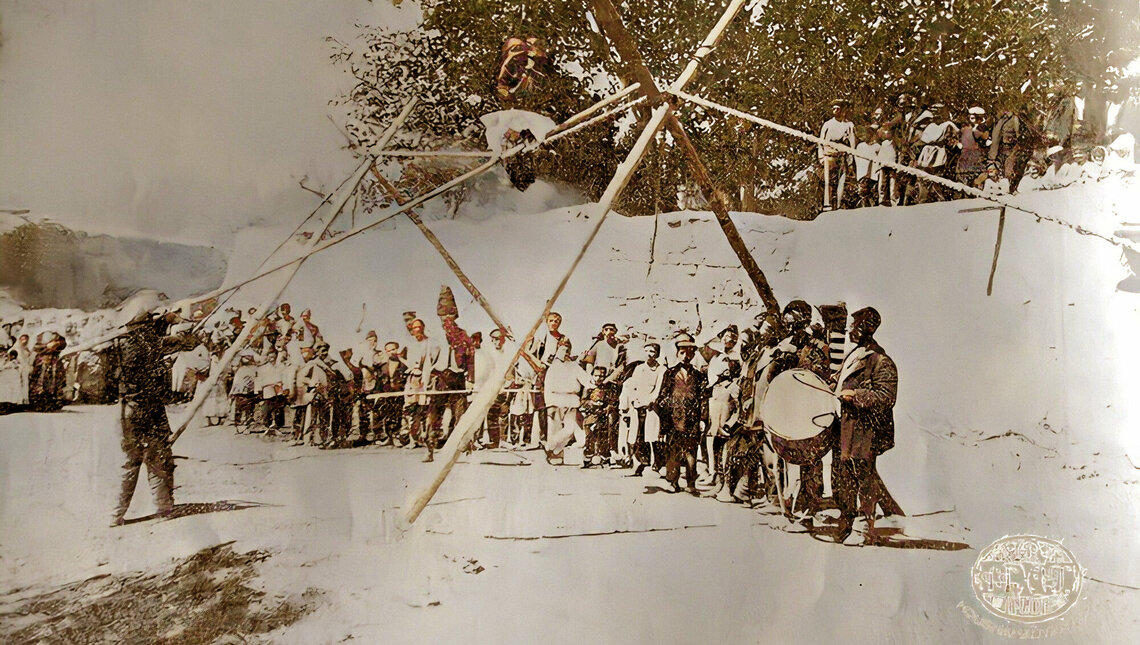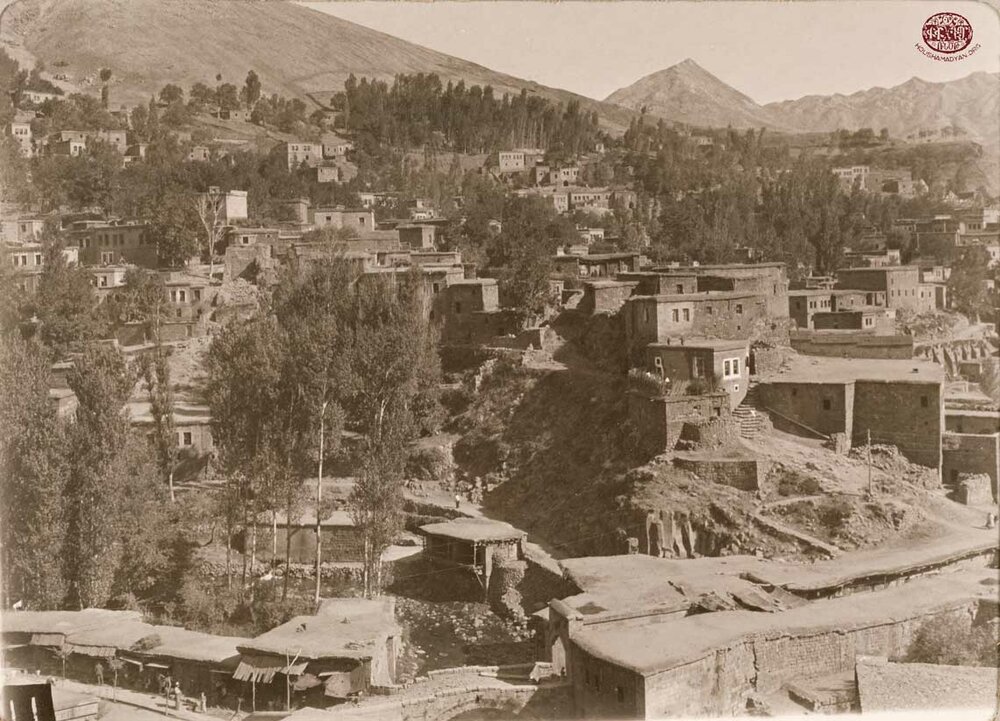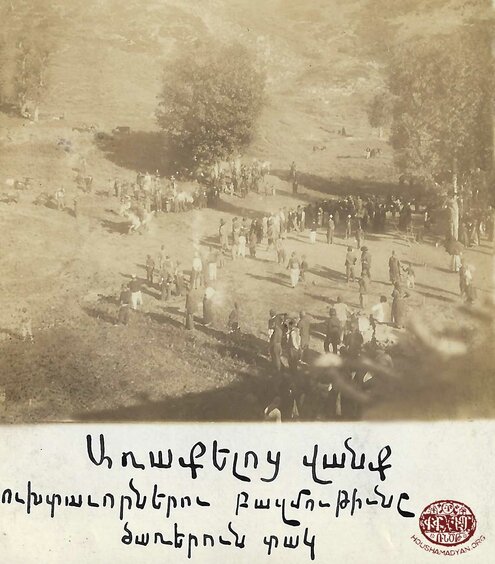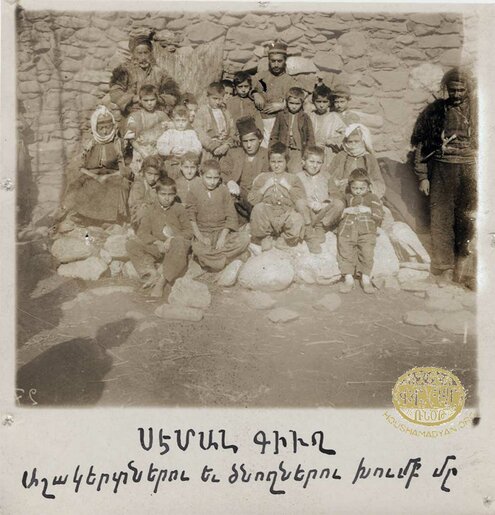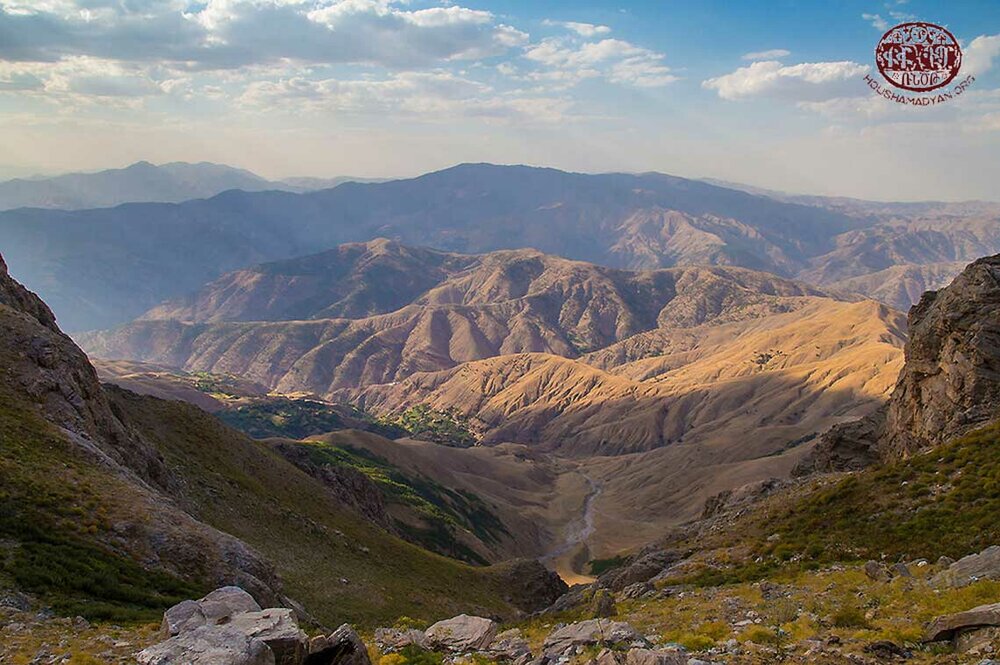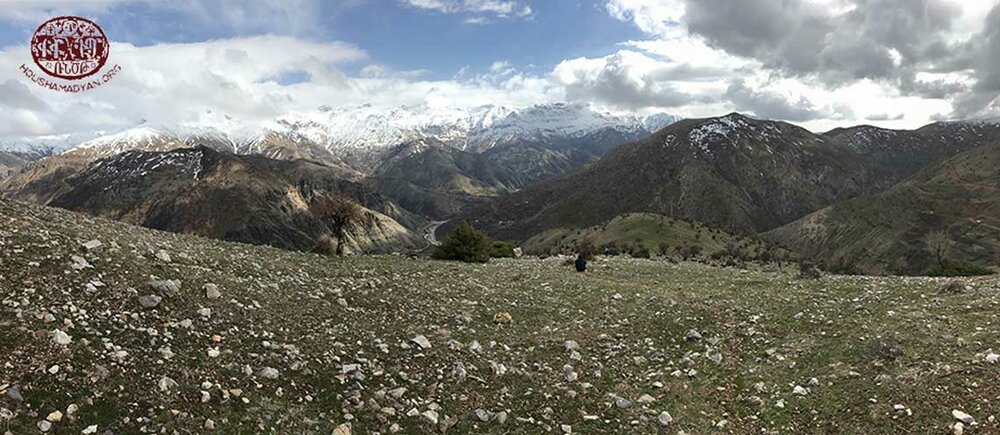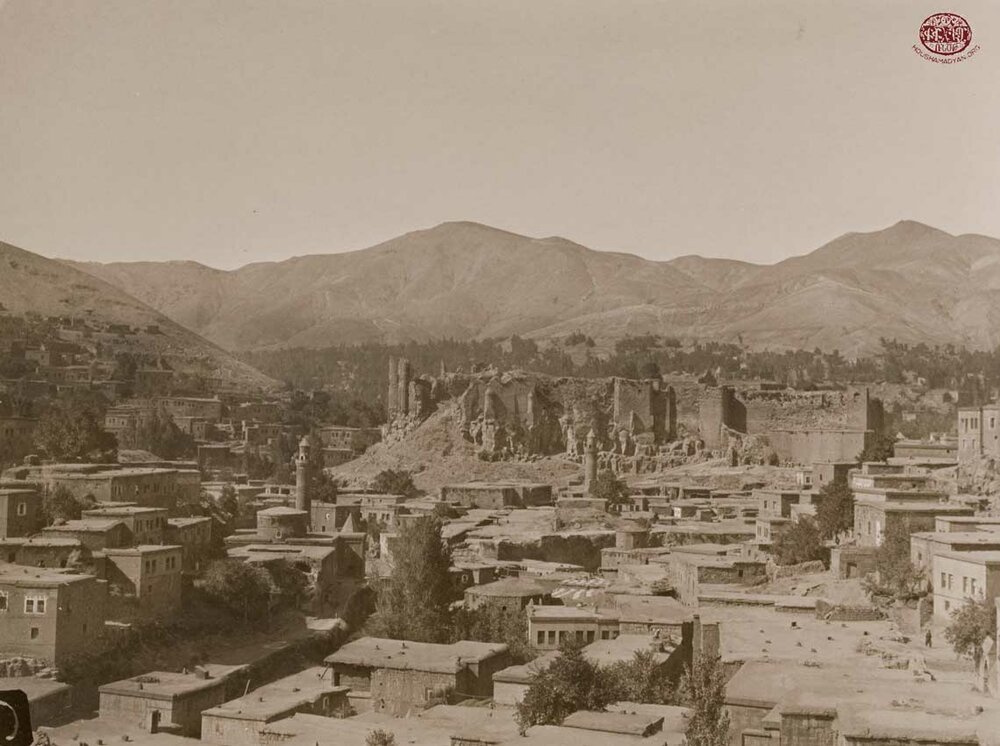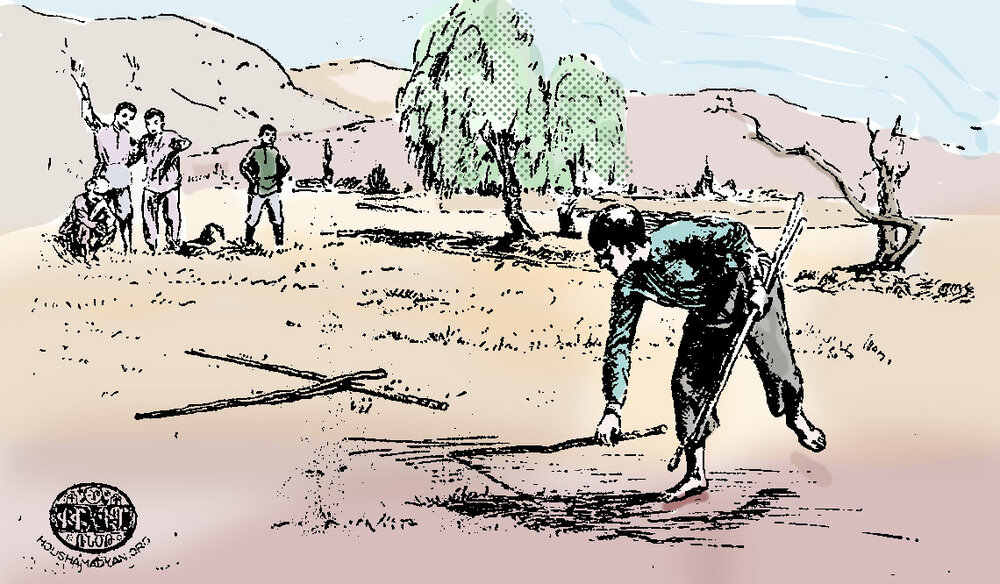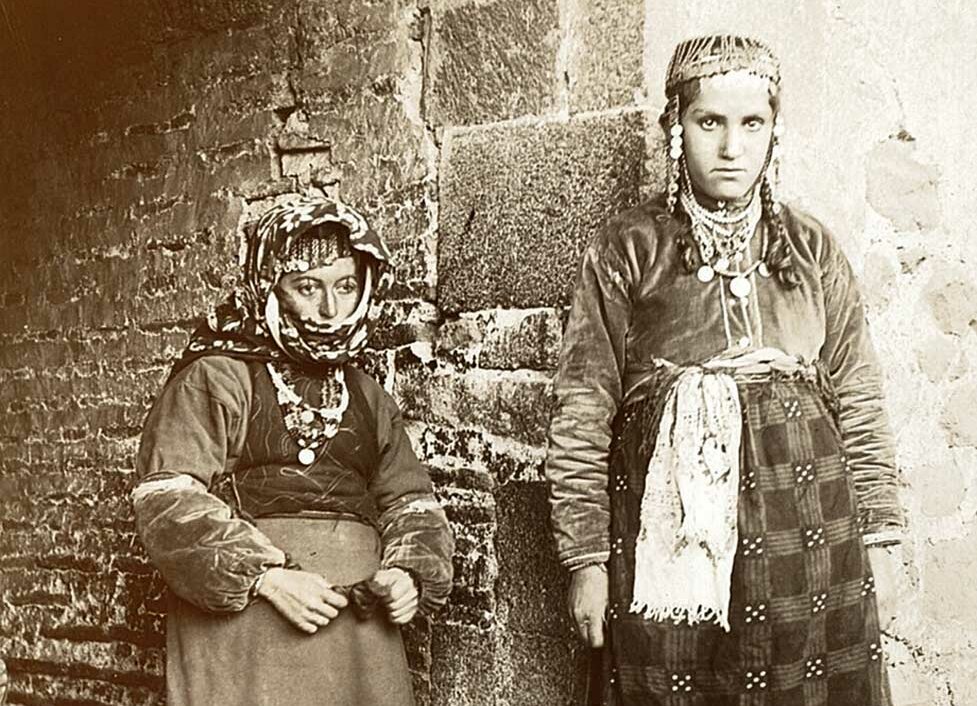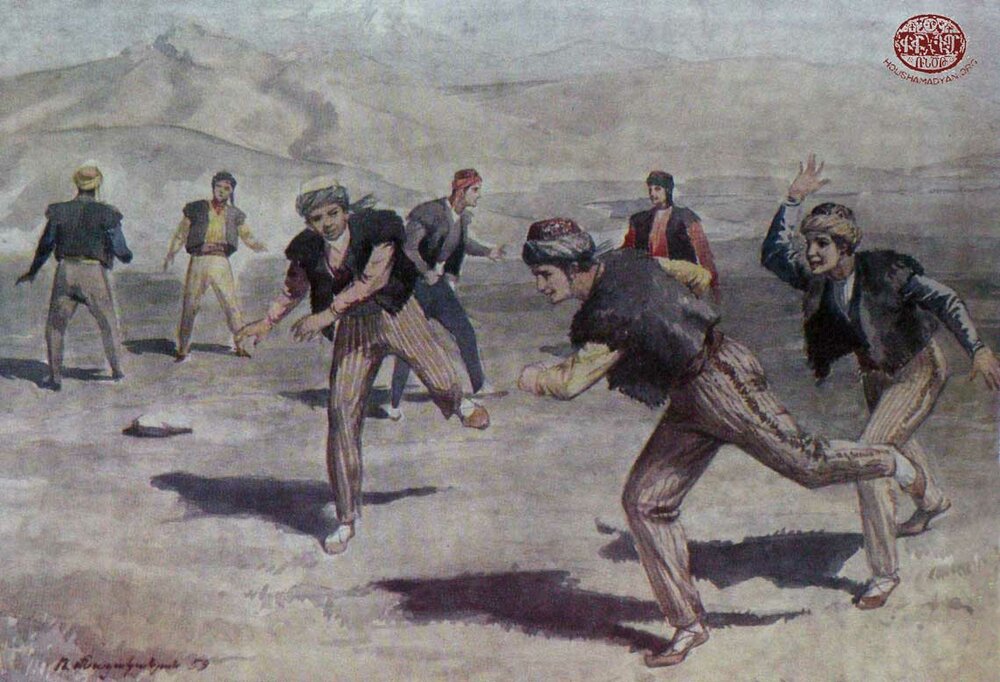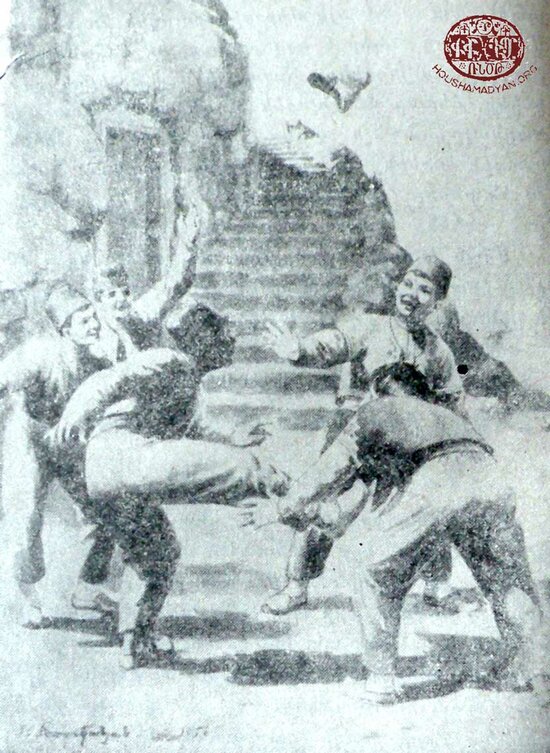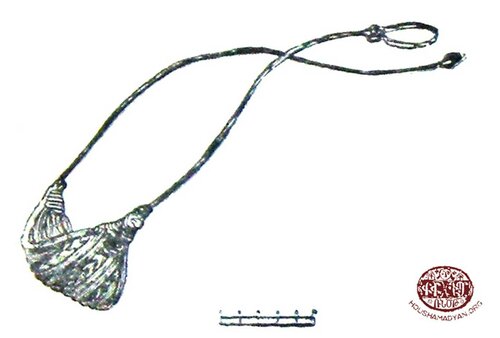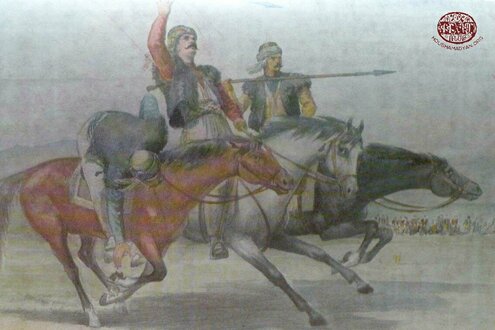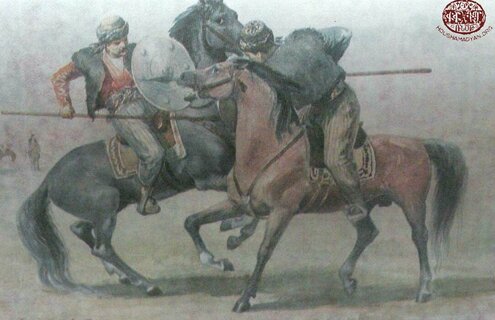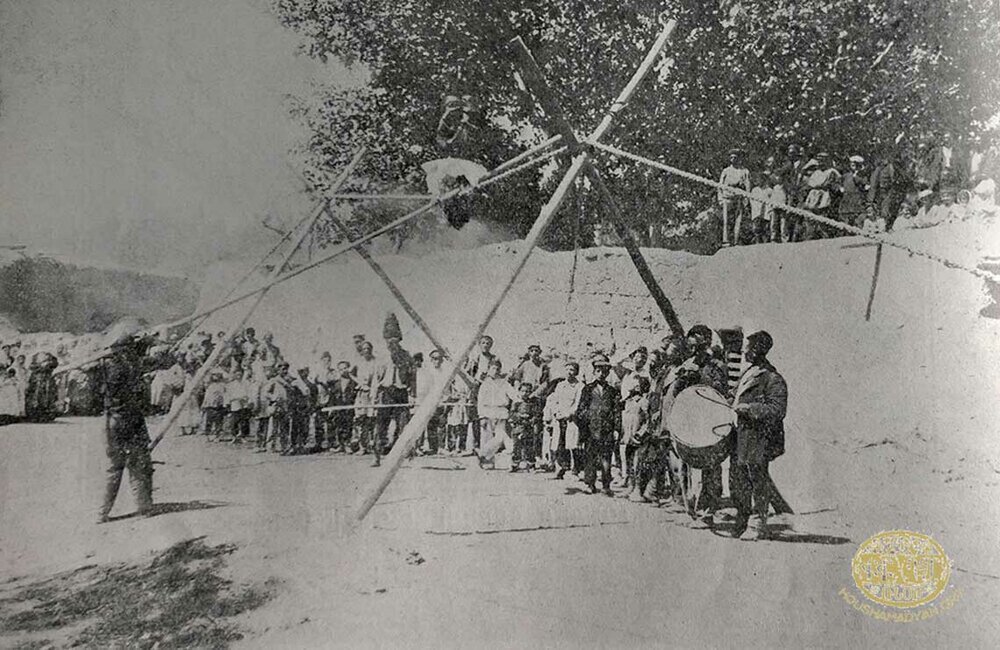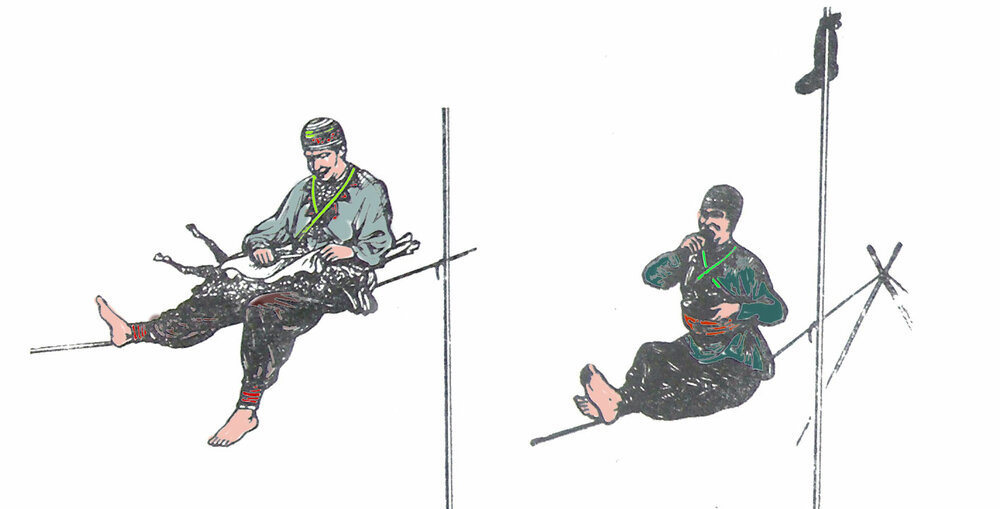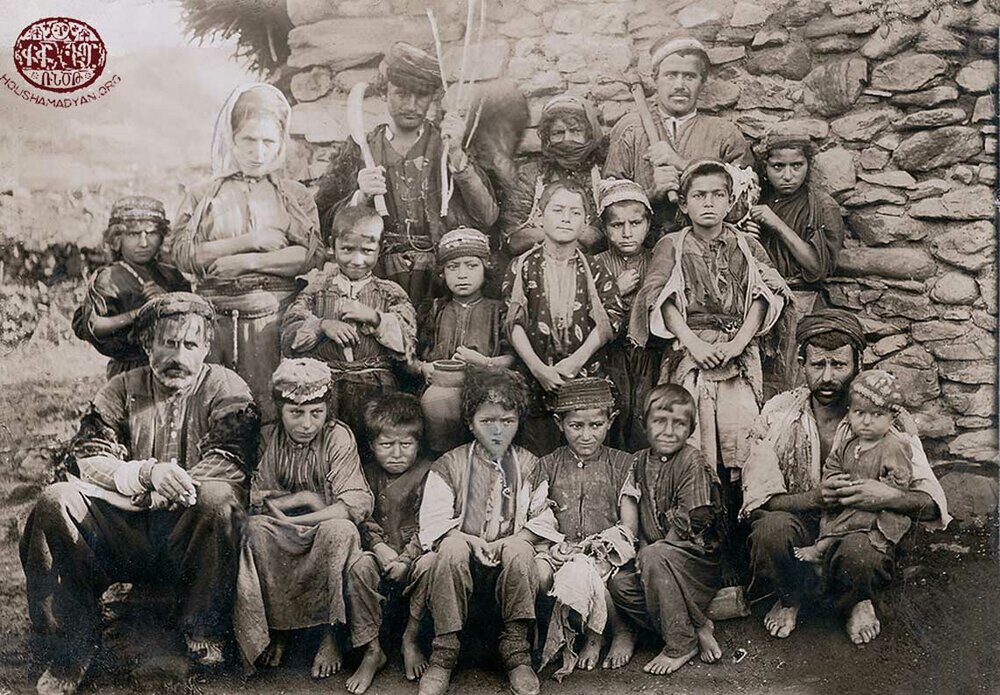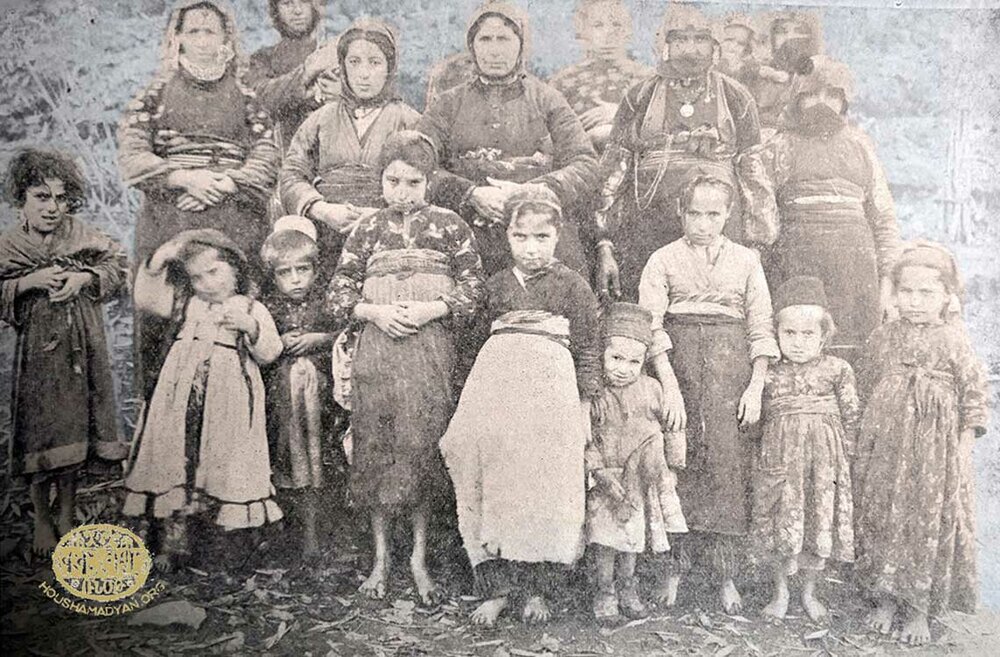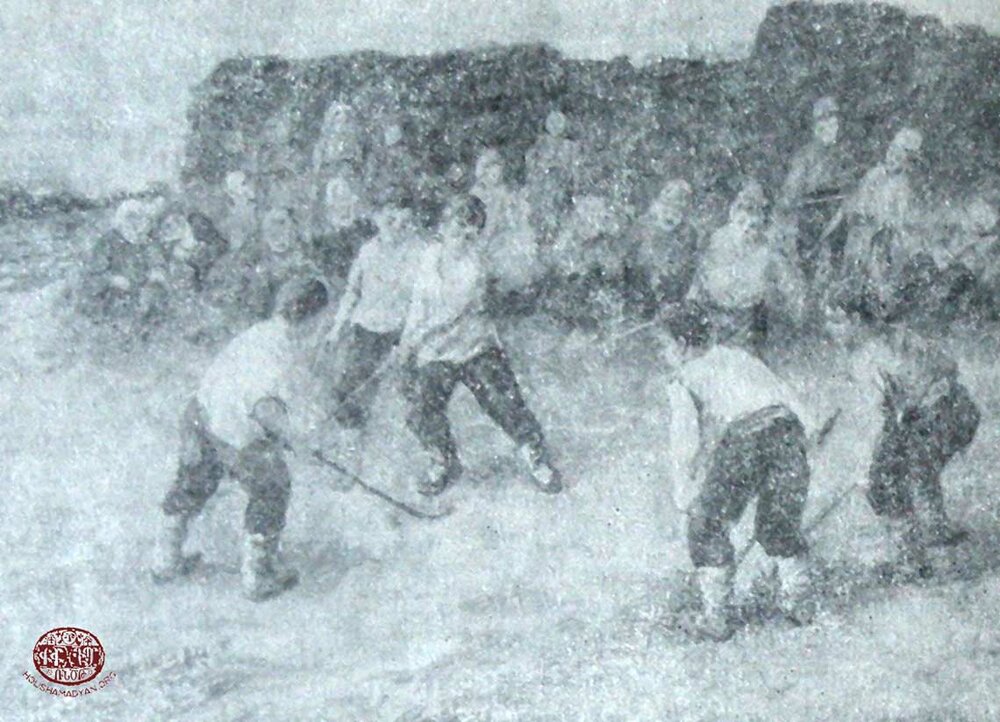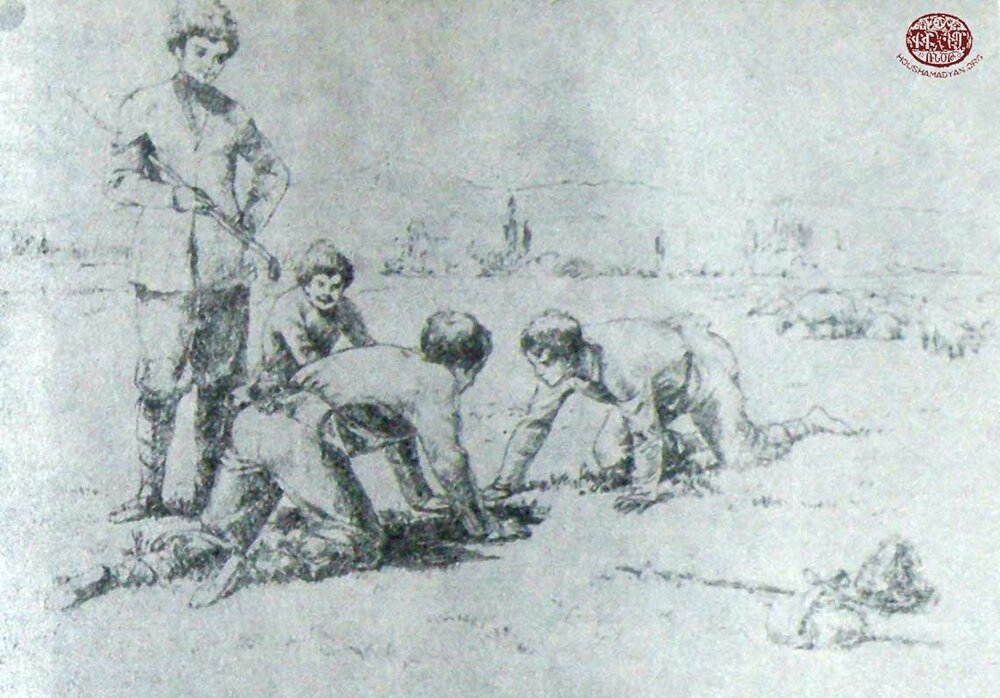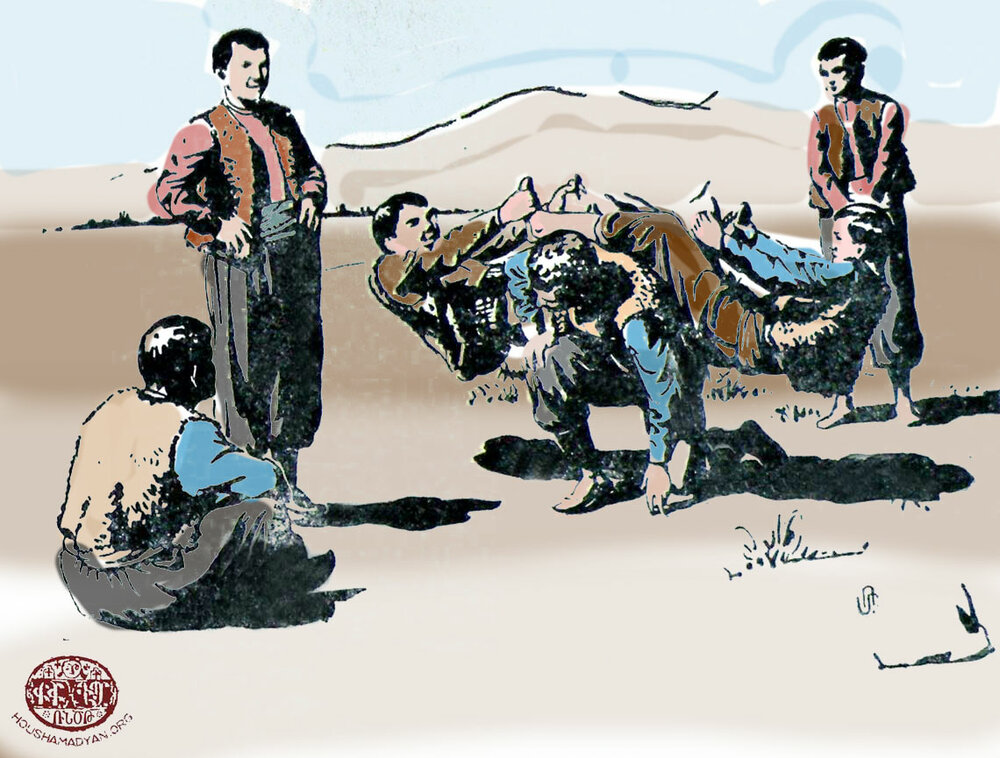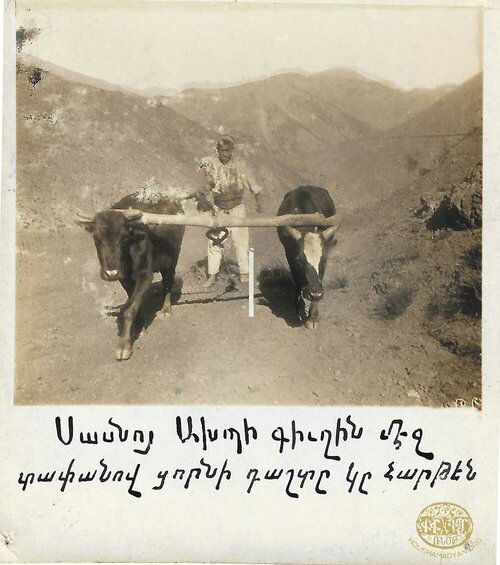Daron – Games

Author: Lory Tashjian, 29/08/2022 (Last modified: 29/08/2022) - Translator: Simon Beugekian
Throughout the world, games are a component of the lifestyles and traditions of societies. Games are a form of leisure, diversion, and competition; they are displays of physical prowess and agility; and they serve to train both the mind and the body. Like folk music and dances, traditional/popular games are opportunities for self-expression, communication, and the creation and cementing of community relations.
Some games gradually even gain the status of traditions and become part of popular ceremonies. For example, in the area of Moush, when a future groom visited the home of his betrothed for the first time, he would be handed a rock, called pesi kar [groom’s rock], which he would have to lift above his head.
This article explores the games played in different parts of Daron (Moush, Sassoun, Bitlis, and Boulanukh), as described in various primary sources.

Yerek Kayl [Three Steps]
According to the information available to us, this game was played in Sassoun by youth between the ages of 10 and 12. The game was played on threshing floors, on the roofs of large barns, or in fields and pastures; usually in the spring or autumn.
At the start, one player would be designated the bab, or the game leader. The Bab would draw a line across the center of the field, then the remaining players would stand at a distance of 10 to 30 strides from that line. They would take a running start, and upon reaching the line, they would skip over it (without stepping on it) by launching themselves forward with one leg. They would then take another two long strides, and finally leap forward and land on both feet. If, for example, the player’s right foot was the last to touch the ground before reaching the line, he would have to skip forward first with his left foot, then with his right, and then finally jump forward and land on both feet. Each player would mark the spot he reached.
Once all the players had jumped, the bab would announce the player who had jumped the furthest, thus declaring the winner.
This game was relatively similar to the modern athletic discipline of triple jump.
According to the same source, this game was also played in Sassoun, where the players would not take a running start, and would instead stand on the line and then jump forward. [1]

Sli-Vli or Slvlig
According to our sources, this game was called sli-vli in Bitlis (Paghesh) and slvlig in other parts of Daron. It was played in homes or barns, by teams of both girls and boys.
The players would sit on the ground in a circle, with their knees lifted and bent at an angle, so as to form triangles. Then, they would pass a hat belonging to one of them to each other surreptitiously through their bent knees, while together chanting, “sul-vul, sul-vul!”
The owner of the hat would be sitting on his knees in the center of the circle, and would have to guess which of the other players had his hat. He was allowed to pat the area under the players’ knees with his hands. Whichever player was caught with the hat would exchange places with the player in the center in the circle. [2]

Dik and Dik
This was a game played by young children in Bitlis.
Two children would sit face-to-face and would interlock their index fingers with their palms facing upward, pretending that their fingers were two roosters locked in combat, while at the same time chanting, “Dik ou dik, baladik.” Dik meant rooster in the local vernacular. [3]

Djiv and Djiv
This was a very popular children’s game, called djiv-djiv in Bitlis and tdziv-tdziv elsewhere.
A mother would play this game with a toddler who had just begun to speak. She would pinch the skin on the top of the toddler’s hand and recite:
- Djiv ou djiv, akrav ou djiv,
- Pourt eper, pampag cheper,
- Morn erav, deghin cherav,
- Akrav knats Yerusaghem,
- Shal erav, shal cherav,
- Frrr!
As she said “frrr!”, the mother would make the shape of bird with her hand, and with it grab the toddler’s belly. The gestures and recitation would elicit the child’s glee and mirth. The game would be repeated as many times as the toddler wished. [4]

Alnis Palnis
This was a game played in Bitlis.
One of the players would conceal a twig in his palm, then make fists with his two hands and hold them in front of the second player. The second player would recite the following while alternately touching the first player’s left and right hands with his index finger:
- Alnis palnis
- Khavadam Sourp Sarkis
- Zil dzil khan dour yis.
The first player would open the hand on which the second player’s finger rested as the ditty ended. If the twig was not in that hand, the same process would be repeated. If the twig was in that hand, the two players would switch roles before repeating the game. [5]

Aghvesag/Aghvusou Dzag [Fox Den]
In Bitlis, this game was called Aghvesag. It was played by 5 to 20 players, usually adolescents. They would stand in a line and squat, in such a way as to make an extended arch with their legs, resembling a burrow or a passage – the aghvesag (or fox den).
One of the players would be the designated bab, and would chase another player, called the “prey.” To escape the bab, the “prey” would have to crawl through the arched legs of the other players – in other words, he was a fox endeavoring to escape through the fox den. The bab could pursue the “prey” by also plunging into the burrow.
If the “prey” was able to make his way down the passage and through it, the bab would become the “prey,” and the previous “prey” would be replaced by the first player in the line. [6]

Edz-Edz
This game was played in various parts of Daron by young men and women, as well as by shepherds and cattle herders. Daron had its own unique version of edz-edz.
A circle with a diameter of 50-60 centimeters would be drawn in the center of a field. The players would take turns standing inside the circle, bending down, and then throwing their hats backwards through their legs as far as possible. The same game could be played by throwing a shepherd’s crook instead of a hat.
One of the players, previously designated the edz-edz, would hold his breath and run around collecting all the tossed hats. He would win if he succeeded in collecting them without running out of breath. Then another player would be designated the edz-edz. But if the edz-edz drew a breath while trying to collect the hats, then he would have to stop where he was and place his hat on the ground at that very spot. This would initiate a new phase of the game, during which the edz-edz would have to perform two tasks – first, he would have to kick his hat into the circle drawn on the ground; and second, he would also have to kick one of the other players. If he succeeded, he would be declared the winner, and the player he had kicked would become the edz-edz.
But it wasn’t quite so simple – because the other players could use their own feet to kick the edz-edz’s hat away from the circle.
Once the edz-edz’s hat landed in the circle, the second stage of the game would begin. The edz-edz would have to kick one of the other players to cement his win.
The other players, to avoid being kicked, could either lie flat on the ground; or they could get both their feet off the ground by standing on a rock or swinging from a branch. The pursuer would keep a close eye on them, and as soon as any of them stepped foot on the ground or stood up, he would chase them down and try to tag them.
A different version of the game was played in Boulanukh by young girls. A line would be drawn on the ground. The players would clutch a stick between their toes, and then chuck this stick as far as they could. Once the stick was airborne, the player would have to hold her breath as she ran after her stick, grabbed it, and then brought it back to the line drawn on the ground, all the while chanting, “Edz, edz!” Whichever player could not hold her breath throughout the process would have her bonnet smashed with sticks.
The version of this game played in Bitlis was quite different, and was called edz-edz or oul-oul. A player’s hat would be placed on a pole. A circle would be drawn around this pole. The other players would throw their own sticks at the pole, with the aim of knocking off the hat. The player who succeeded in doing so was declared the winner. If none of the players was able to knock off the hat, the sticks that the players had thrown into the circle would be forfeit and become the property of the hat’s owner. At this point, the players would have to run into the circle and rescue their sticks without being tagged by the hat’s owner. [7]

Dabo [Hole Game]
This game was played in Bitlis.
A hole was dug into the ground. One of the players would stand beside it, and another would stand at a distance, and from there toss walnuts, trying to get them into the hole. At the end, the walnuts would be counted. If the number of walnuts that had gone into the hole was even, the pitcher would win, and his opponent would owe him the same number of walnuts. If the number was odd, the player standing beside the hole would win, and the players would exchange roles. [8]
Agnchetsoug
In Bitlis, adults would play this game with children to entertain and amuse them. It could also be played by two children. The two players would hold each other’s ear lobe and exchange the following lines:
- Player A: Did you take water to the wife of the emir?
- Player B: I did.
- Player A: Was it hot or cold?
- Player B: It was hot.
- Player A: Cool it down.
- Player B: It’s cold.
- Player A: Heat it up.
- Player B: It’s hot.
The game would go on until one of the players made a mistake and gave the wrong “hot” or “cold” answer. The winner would get to pull the loser’s earlobe. [9]

Ponta
This game was played in Bitlis. Two boys would stand beside each other, and each would interlock his fingers and hands behind his back. A third boy would stand on their hands and hold on to their heads. In this position, the boys would take as many strides as possible. [10]
Chour
A distinctive version of this game was played in Bitlis, as follows: the defending team would control an area called the “fort.” A rag would be placed in the fort, and the defenders would have to defend this rag from the raids of the attacking team. The attackers had to enter the fort and capture the rag without being captured by the defenders. If they succeeded in capturing the rag, they would win. [11]
The game was played in Boulanukh with slightly different rules. In this version, 10 to 20 boys would participate in the game, split into two teams. A circle would be drawn in the center of the playing field, and the defending team would stand inside this circle. A stone would be placed in the center of the circle, called the chour. The aim of the attacking team was to run into the circle and step on the chour, in which case they would win the game. However, the defenders could eliminate the attackers by simply tagging them. On the other hand, if an attacker was able to juke a defender and enter the circle without being tagged, that defender would be eliminated from the game. In the end, if the chour was not captured by the attackers, the team with the fewest eliminated players would win.
The version of this game played in Sassoun was similar to the version played in Boulanukh. The only difference was that the game was instead called pur. It was played in the springs and autumns, by groups of 20 to 40 players. [12]

Tossing a Ktag
This game was played in Sassoun by teams of eight to ten boys. The teams would each draw a line on the ground, approximately 50 meters from each other, and stand behind their respective line.
The game would begin with a member of one team approaching his competitors, grabbing a hat off one of them, and running back to his team’s line. The owner of the hat had to chase down the thief and manually tag him before the latter reached his team’s base. If he succeeded, he would get his hat back, and the teams would exchange roles. If he failed, he would be captured by the opposing team.
The game would continue until one team captured all the opposing players. [13]
Kloula [Ball]
Children in Bitlis would arrange nails, beads, or walnuts in a row, then would step back to a line drawn on the ground and roll a ball from behind this line towards these objects, trying to strike them. Each object struck became the property of the player who rolled the ball. Each player rolled his ball until he missed. It would then be the turn of the next player to roll his kloula. [14]
Top
In Sassoun, this game was played by adolescents and adult men, split into two teams, in a large field.
Each team had its owl gopal. This was a thick plank of wood with a tapered end. The gopal was used to strike the ball. Aside from the gopals, the game necessitated an apple-sized ball, which was wound of hair or wool.
Each team would select a hitter. A player from the first team would toss the ball towards the second team’s hitter, from behind a line previously drawn on the ground. The hitter would strike the ball hard, sending it back in the opposite direction. The players on the first team would have to catch the ball before it hit the ground.
If the hitter failed the strike the ball with the gopal, he was considered “dead,” and was eliminated from the game and replaced by another hitter. Each player had only one chance to hit the ball. Top was a primitive version of the modern game of baseball. [15]
Karklor
This game was played by adolescents in Sassoun. They would first split into two teams, team one and team two, each consisting of two or three players. They would stand in a large field, facing each other, at the distance of a stone’s throw.
Each team would erect three flat and long stones in their area, leaving a gap of one meter between them. A player from the first team would throw a rock and try to hit one of the second team’s stones. If he succeeded in knocking a stone down, he would move on to the second stone. If not, it would be his teammate’s turn. The first team that succeeded in knocking down all three of the opposing team’s stones would be declared the winner.
The best karklor players would be given the title of nshan tari, meaning marksman. [16]

Babe-Babe
In Daron, this game was played during the months of spring by shepherds and other cattle herders. It was played in green fields and pastures, by four or sometimes more players.
The game was played using staffs (sticks and crooks) and arakhchis (multi-colored men’s hats knitted with wool threads).
To prepare for the game, the players would stand behind a line drawn on the ground. Each would hold a stick in his hand. Each player would toss his stick as far as he could from just behind the line. The owner of the stick that landed closest to the line would be the designated babe or bab. As for the others, they would be ranked from first to last, according to how far they were able to toss their sticks. The one who had thrown his stick the furthest would be ranked first, and so on.
The bab would plant his stick into the dirt at a distance of about seven to ten strides from the line, hang his hat from the stick, and stand beside it.
The first of the other players would jump to his feet, approach the stick planted into the ground, and begin the following conversation with the bab:
“Babe, babe. Good morning to you!”
The bab would replay: “Two rotten fish to you!”
Immediately upon hearing the bab’s response, the second player would use his stick to try and knock the hat off the bab’s stick. Then, the same player, jumping on one foot only, would have to make his way to the fallen hat and pick it up. This would bring his turn to an end. But the other players could impede him by hitting him with their hats or other soft objects while he attempted to collect the bab’s hat. This player – always balancing on one foot – could strike the other players who approached him with the stick in his hand. [17]
Kleran
Kleran was a game played by children in Bitlis. Kleran was the name given to wooden wheels, which were usually affixed to carts. But it was also the name given to a toy made for children, which they would roll down from the roofs of houses. Larger klerans were also rolled down hills. These larger klerans were called klers. [18]
Playing Djan
In Sassoun, marbles/beads were called chan or djan in the local dialect.
The game was played by two players, usually children.
Colorful marbles were arranged in a row, about ten centimeters apart. The first player would stand behind a line drawn on the ground, and from there toss marbles at the ones arranged on the ground, hoping to strike them. Any marbles that he struck became his. Once he missed, he relinquished his turn to the second player.
The players would thus take turns until one of them was able to acquire all the marbles. [19]

Aquatic Games
In Moush, the breaststroke style of swimming was called kordnlogh [frog swimming]. [20]
In Bitlis, children played a game in the water called kol. Two children would face off and splash each other with water. The first to beat a retreat was considered the loser. [21]
Barsend, Barsid, Barshta
In many areas of Daron, slings were called barsend.
Barsends were made by young girls, using colorful wool thread, and rarely with leather. These girls would then gift the slings they made to boys who were shepherds or cattle herders. The latter would hang the slings from their belts.
The sling would consist of a pouch, where the stone would be placed, and two straps projecting from each side. One of these straps would end with a ring, which would be worn on the index finger.
Barsends were used to defend fields and pastures from birds. Sometimes, youth also organized mock battles with their slings or competed over who could strike the furthest target.
In Sassoun, slings were called barshta. The pouch was usually made of treated leather, which would have an oval shape, with a diameter of 10-15 centimeters. This pouch would be attached to two hemp straps, each with a length of about 80-100 centimeters.
Youth would use their barshtas to hit boulders or to knock down rocks.
In Bitlis, slings were called barsid. [22]

Horse Racing/Horse Vaulting
Horse races were a popular form of entertainment in Daron. They were organized to celebrate weddings, Ascension Day, Vartavar (Transfiguration of Christ), and especially the feast day of Saint Garabed.
On the feast day of Saint Garabed, in addition to locals, participants in the horse races would include the best riders from Garin/Erzurum, Vasbouragan, Khnous, and elsewhere.
The horsemen would ride up and down a pre-designated track to the accompaniment of special horseracing music played by the bands. On Saint Garabed, equestrian events also included jumping over hurdles and jousting.
Among those who had become renowned for their riding skills was Iritsou Krikor, a resident of the village of Khars (present-day Güneyik). During his performances, he would awe the crowd by standing on the saddle, sometimes even standing upside-down on his head. He would swing under the horse’s neck and get back on the saddle from below, or he would collect items from the ground while still riding his mount. Another well-known rider was Kavrotsi Moso.
Many songs were sung about the heroes of local horse races and equestrian competitions. [23]
Choukhd and Fard (Tar and Godjad)
This game was played in Bitlis.
The game was played with walnuts, acorns, or other small nuts or foodstuff. One child would keep an odd or even number of walnuts in his hand. The second player would face the first, and guess either tar (even) or godjad (odd); or choukhd (even) or fard (odd). If the second player guessed correctly, he would win the food hidden in the first player’s hand. If he guessed incorrectly, the two players would exchange roles. [24]
Tightrope Walking/Acrobatics
There were many tightrope walkers/acrobats in the area of Moush. They often plied their trade during the various pilgrimages organized at the Saint Garabed and Saint Arakelots monasteries.
Among the better-known acrobats was Hadji, who hailed from the village of Arakh in the Moush Valley. His favorite haunting ground was the Saint Arakelots Monastery, where he would perform once a year. It was said that while sitting on the tightrope, he could slaughter a sheep and chop the meat. He would then be handed a grill, which he would also balance on the tightrope, and proceed to roast the mutton on skewers. Hadji was also an expert stilt walker. His stilts were four to five meters long, and while on them, he could dance to the music of the daoul and zourna. [25]
Badtsig
This game was played in Bitlis.
One player would bury nails, beads, or coins in the ground. Then, the surface of the ground would be split into squares. Each of the other players would stand in a square. Any items buried in that square would become the property of that player. [26]
Zundjle
This game was played in Bitlis.
Several players would sit beside each other, holding their knees with their hands. Another player would stand facing them, and recite the following lines while touching each of them with the index finger alternately:
- Zundjle, be zundjle,
- Msre gatakh Ava goze
- Ava bde, dzour markare
- Dzag derdir e.
With each word pronounced, the reciter would place his finger on one of the seated players. The last player on whom the finger rested would be the “designated” player. This player would lean down and forward, and the other players would take turns touching his back with their fingers. The designated player would have to guess the identity of the players touching him. [27]
Djghor [Swings]
This game was played in Bitlis.
A rope would be suspended from a height, and children, either singly or in groups, would hang on to it and swing back and forth. The rope could also be suspended from a tree branch, in which case it would be called charkha feleg. [28]
Sadani Mernel [Death of Satan]
This game was played in Bitlis.
One player would lie on the ground in the supine position, and the others would place rocks on his feet, knees, palms, and mouth. Then, knocking rocks against each other, they would run in circles around the first player, chanting:
- Ari sadana,
- Zes Merel tagha.
- [Come Satan,
- And bury me as the dead.]
The player lying on the ground would suddenly jump to his feet and begin pelting the other players with the rocks they had placed on his body. [29]
Tumpo-Tumpo
This game was played in Boulanukh.
It was a game based on a repartee between an adult and a child. The adult would hold the child’s hand and begin:
- Adult: Tumpo-tumpo.
- Child: Ha!
- Adult: What is your mom cooking?
- Child: Kaladjosh [a dish made with lentils and yogurt].
- Adult: What is that soft meat?
- Child: It’s breast meat.
- Adult: What have you lost?
- Child: A gold ring.
- Adult: Where did you lose it?
- Child: On the roof of the church.
Then the child would say, “Yes im kidi, ou chem ita,” and would immediately run away, while the adult would chase him down. [30]
Achkhpogits
This game was played in Boulanukh.
One player would be blindfolded, and the other players would push, hit, and prod him from all sides. The blindfolded player would try to grab a hold of the others. Whomever he caught would then assume the role of the blindfolded victim. [31]
Dzer or Der
This game was played in Boulanukh.
It was identical to achkhpots, except that it was played without a blindfold. [32]
Pa vor Darav?
This game was played in Boulanukh.
Five to six players would sit in a circle. In the center of the circle would sit another player, who would keep an object from each of the other players.
The player in the center would ask, “Pa our darav?” The player being asked would answer, “Yes ip dara, ha ina darav.” Then the player in the center would turn to another player and ask, “Pa our darav?” and would receive the same answer. The game was more of a form of entertainment, rather than a way of guessing where the hidden objects were. [33]
A similar game was called Sulu. Players sitting in a circle would once again hide objects, but in this case, they would secretly pass them to each other. The player sitting in the center would have to guess which player had possession of which object. [34]
Ghazalo
This was a popular game played in Boulanukh.
The players would be split into two teams. The first team would hide in the village, while the players of the second team would look for the first team, alongside one representative from the first team. This latter would scream information to his teammates constantly: “Ghazalo! We’re here! We’re in the upper neighborhood!”; “Ghazalo! We’re here! We’re on the roof!”; “Ghazalo! We’re here! We’re going down to the lower neighborhood!”; etc. Based on this information, his teammates, at the right time, would leap out of their hiding spots, surround the seekers, attack them, and beat them. If any of the seekers cried, “Ray, ray!” (“We surrender, we surrender!”), the game would end. [35]
Keri [Hostage]
This game was played in Boulanukh.
Two teams, consisting of 10 to 20 players each, would face each other across an open space. A player from the first team would make a foray towards the second team, with the intention of capturing a hostage. The second team would send one of its players to confront him. When these two players approached, the attacking player would have to tag the defending player and immediately return to his team’s base. The defender would have to chase him down and tag him back. If the latter succeeded, the attacker would be considered eliminated, otherwise, the defender would be eliminated. The game would proceed in this manner until all players on one of the teams were eliminated. [36]
Prnoug Hol
This was a primitive version of the game of hockey, played in the autumn in various areas of Daron.
The game would be played by 10 to 20 players, sometimes more, in a flat field or pasture. The players would be split into two teams, and each player would hold a staff with a crook. The game was played with a wooden ball. Each team had its fort (or goal), and each team’s objective was to get the wooden ball into the opponent’s fort.
Before the start of the game, the players would stand in a row, on the outside of a line, about five-ten meters from each other. The ball would be placed at the center of the field. A player from the first team would use his crooked staff to strike the ball, and would send it towards the opposing side of the field. At that point, the rest of the players would run into the field, and each team would attempt to move the ball towards the opposing team’s goal and to score.
The game would go on like this for an hour or two. Naturally, the team who scored the most goals would win the game. [37]

Gdeis Hol
This game was played in Daron. It was played by four players, split into two teams – defenders and attackers.
The game was played on a flat field with a length of 60-80 meters and a width of 30-40 meters. In the center of the field, the players would dig a hole measuring about 10 centimeters in width and in depth. Two smaller holes would be dug about two meters on each side of the larger hole. These smaller holes were called gdeis. The game was played with a wooden ball, and each player would carry a staff with a hooked end.
The defending team would stand on the right and left of the gourdan, with their left heels in the gdeis.
The players of the attacking team would stand at least ten meters away, and with their staffs would try to guide the ball into the gourdan. Meanwhile, the defenders, without ever removing their heels from the gdeis, would have to parry away the ball and prevent it from falling into the gourdan. The attackers would have to chase down the ball and strike it again before it came to a complete stop. [38]
Nam-Nam Poutig (or Sunapert)
This was a fort dance/game played in Sassoun, usually in the winter, in homes or in barns.
One of the players would be chosen by lot to be the designated defender of the fort, while the others, in groups of seven to ten, would attack and attempt to capture the fort. The defender had to keep one hand in contact with the fort at all times, but he could use his other hand and his feet to ward off the attackers. If he succeeded in tagging any of the attackers, the latter would be eliminated from the game. The defender would win the game if all the attackers were tagged.
The aim of the attackers was to exhaust the fort’s defender by striking and slapping him. One of the attackers could also jump onto the defender’s back, as long as his feet did not touch the ground. However, this player could not also strike the defender with his hands. The same rule applied to the defender, who would not hit or strike the attacker who had jumped on his back. [39]
Archakhagh [Bear Game]
This game was played by children in Sassoun. It was basically a staged battle between a bear and a shepherd. One player would dress in a shepherd’s attire, while another player would be dressed in bearskin and pretend to be a bear. The other children would play the role of the sheep in the shepherd’s flock.
Then, a fight would begin between the “bear” and the “shepherd,” eventually resulting in the bear’s death, eliciting wild cheers from the “sheep.” [40]
Pur
This was a very common game in the Armenian Highlands. In Sassoun, it was played in the springs and autumns. Sometimes, up to 40 players would be involved in a game.
A pur was a large rock, which played the role of a fort in the game. It would be placed in the center of a large field. The players would be split into two teams, attackers and defenders. The defending team’s goal was to defend the fort.
The defending team would designate a fort keeper, who would stay close to the fort, while his teammates would try to chase down the attackers. The latter would attack the fort from all directions upon a signal from their leader.
If a defender succeeded in tagging an attacker, the latter was “killed,” or eliminated from the game. However, if one of the attacking players was able to step on the fort, the attacking team would be declared the winner and the teams would exchange roles. In other words, the attacking team would become the defending team, and vice-versa.
The game would continue until all players on one of the teams were eliminated. [41]
Buffalo Fighting and Billy Goat Fighting
One of the most popular pastimes in Daron was buffalo fighting. These events would take place on certain holidays, such as Ascension Day. A large crowd of spectators would attend the fights. The same events would also host nokhaz (billy goat) fighting). [42]
Yarkhoushda
Yarkhoushda was one of the favorite games of the Armenians of Sassoun. It was usually played in the presence of many spectators. The participants were adolescents and young men, or even older men. The game was accompanied by music played on the daoul and zourna.
The two teams would begin by facing off. At first, they would sing and dance separately, then they would “attack” each other by raising their arms and slapping their “opponents” in the hands. The two rows of players would then retreat to their original positions and repeat the process.
Those who played/danced the yarkhoushda would dress in military attire, and would also carry a dagger, which hung from the front of the right side of their belt.
This game was played during pilgrimages; during the feast days of the Antog, Mount Marouta, Dzovasar, and Saint Garabed of Moush monasteries; as well as during weddings and feasts. [43]
Pambagi Yertal
This was a game played in Sassoun in the winters. The player would balance himself on a stick about half a meter to a meter long, which would be suspended from the rafters of the ceiling by ropes that would then hang back down in the other direction. The player balancing on the stick would hold the ends of the ropes and pull them down, which would allow him to gradually rise. If he succeeded in reaching the ceiling, he would have successfully pambagi yertal [gone to cotton]. If he fell at any point, he would relinquish his turn to the next player. [44]
Komshagriv
This game was played in Daron.
It was played by four or more boys between the ages of 8 and 12, in fields and on threshing grounds, as well as on the banks of rivers.
Two of the players would be the designated babs, and the others would be split into two teams.
A circle would be drawn in the center of the field, with a diameter of one to two meters.
Upon a signal from the babs, one player from each team would enter the circle. The two would get down on their knees, grab each other with the hands, and rest their heads against each other’s shoulder.
Upon another signal from the babs, the two players would begin grappling, with the aim of pushing their opponent out of the circle. However, both had to remain on their knees.
For each victory, each team would score one point. In the end, the team with the most accumulated points would win. [45]
Raising a Ter
This game was played in the villages of Daron by adolescents and youth, in the winters and springs, in homes, fields, or on threshing floors.
A ter was a sack, resembling a saddlebag, made of hair or wool, with two attached straps. Ters were used to transport wares on the backs of mules and donkeys.
The game was played by three players. Chief among them was the lifter of the ter. He would lie down on the ground, in the prone position, basically emulating a pack animal. The two other players would sit on each side of the first player, facing each other. They represented the ter. They would stretch their legs forward, resting them on the first player’s back. Then they would grab each other’s legs and hold that position.
The first player, using his arms and knees, would have to rise and raise the ter, meaning the two other players, on his back. This player could also grab the other players with his hands to keep them from falling. [46]
Dshi
This game was known in other areas as chelig. Its Bitlis version was unique. It required two different types of sticks – one short, about 25 centimeters in length, called dshi; and the other longer, about 70-80 centimeters in length, called doush.
The players would be divided into two teams. The first team would occupy a height, and the second team would face the first, standing downhill from it.
One of the players standing on the height would balance the doush on two rocks, in such a way that the tips of the stick rested on the rocks. Then, he would strike the doush with the dshi, sending it up into the air, and continue striking it repeatedly while still in mid-air, sending it down the hill at a high speed. The players at the foot of the hill, in their turn, had to strike the flying doush with their dshis, sending it back uphill. If any one of the players standing downhill successfully grabbed the flying doush with his hands, his team would win, and the two teams would exchange roles. [47]
Esh ou Komesh [Donkey and Buffalo]
This game was played in Bitlis.
One of the players would stand with his back against a mound. A second player, facing the first, would bend down and place his head against the first player’s chest. Behind this second player, two more would bend down and hold on to each other. The other players would take a running start and leap onto this human chain. The first leaper would have to land on the first of the players bending down, and so on.
Those of the leapers who could not stick their landing would go to the back and join the line of players bending down and holding each other. [48]
Drungouza [See-Saw]
This was a very popular game in the region of Daron, played by young children, both girls and boys.
A plank of wood would be placed across a tree stump, a rock, or a mound of dirt. A child would sit on each end of the plank, and the two would take turns pushing each other up and down. [49]
Goztrnog [Bending Down and Flying]
This game was played in Sassoun, in large fields, by children and youth.
One of the players would bend down at the waist, spread his legs, and hold his knees with his hands. The other players would place their hands on the first player’s back and jump over him, spreading their legs wide. After jumping, each player would take two steps forward and lean down in his turn, assuming the same position as the first player.
The game would result in the formation of a long line. Thus, the game would become more entertaining if a larger number of players was involved. [50]

- [1] V. Ptoyan, Hay Joghovrtagan Khagher [Armenian Folk Games], volume three, Armenian Soviet Encyclopedia – Academy of Sciences, 1983, Yerevan, p. 80.
- [2] Ibid., pp. 137-138; Toukh-Grbo, “The Games of Paghesh,” Puragn, 10 Nov. 1899, Constantinople, New Series, year 17, number 45, p. 712.
- [3] Toukh-Grbo, “The Games of Paghesh,” Puragn, 10 Nov. 1899, p. 714.
- [4] Ibid., p. 713.
- [5] Toukh-Grbo, “The Games of Paghesh,” Puragn, 3 Nov. 1899, Constantinople, New Series, year 17, number 44, p. 698.
- [6] Ibid., p. 699.
- [7] Ptoyan, Hay Joghovrtagan Khagher, volume three, pp. 55; Toukh-Grbo, “The Games of Paghesh,” Puragn, 10 Nov. 1899, pp. 712-713.
- [8] Toukh-Grbo, “The Games of Paghesh,” Puragn, 10 Nov. 1899, p. 715; V. Ptoyan, Hay Joghovrtagan Khagher, volume two, 1980, Yerevan, p. 143.
- [9] Toukh-Grbo, “The Games of Paghesh,” Puragn, 3 Nov. 1899, p. 698.
- [10] Ibid., p. 699.
- [11] Toukh-Grbo, “The Games of Paghesh,” Puragn, 10 Nov. 1899, p. 714.
- [12] Ptoyan, Hay Joghovrtagan Khagher, volume two, pp. 100-101.
- [13] Ibid., p. 120.
- [14] Toukh-Grbo, “The Games of Paghesh,” Puragn, 3 Nov. 1899, p. 699.
- [15] Ptoyan, Hay Joghovrtagan Khagher, volume two, p. 113.
- [16] Ibid., p. 127.
- [17] Ibid., p. 129.
- [18] Toukh-Grbo, “The Games of Paghesh,” Puragn, 3 Nov. 1899, p. 698.
- [19] Ptoyan, Hay Joghovrtagan Khagher, volume two, p. 150.
- [20] Ibid., p. 168.
- [21] Toukh-Grbo, “The Games of Paghesh,” Puragn, 3 Nov. 1899, p. 698.
- [22] Ptoyan, Hay Joghovrtagan Khagher, volume two, p. 175; Toukh-Grbo, “The Games of Paghesh,” Puragn, 10 Nov. 1899.
- [23] Ptoyan, Hay Joghovrtagan Khagher, volume two, p. 196.
- [24] Ibid., p. 713.
- [25] Ptoyan, Hay Joghovrtagan Khagher, volume three, pp. 183-185.
- [26] Ptoyan, Hay Joghovrtagan Khagher, volume two, p. 714.
- [27] Ibid., p. 712.
- [28] Ibid., p. 713.
- [29] Ibid., p. 714.
- [30] Pense, Poulanukh gam Hark Kavar [Poulanukh or the District of Hark], Y. Lalayan (editor), G. Mardirosyants Printing House, Tbilisi, 1901, p. 136.
- [31] Ibid.
- [32] Ibid.
- [33] Ibid.
- [34] Ibid.
- [35] Ibid.
- [36] Ibid., p. 137.
- [37] Ptoyan, Hay Joghovrtagan Khagher, volume two, p. 185.
- [38] Ibid.
- [39] Ibid., p. 102.
- [40] Ibid., p. 89.
- [41] Ibid., p. 101.
- [42] Ptoyan, Hay Joghovrtagan Khagher, volume one, pp. 172-173.
- [43] Ptoyan, Hay Joghovrtagan Khagher, volume two, pp. 83-84.
- [44] Ibid., p. 60.
- [45] Ibid., p. 56.
- [46] Ptoyan, Hay Joghovrtagan Khagher, volume two, p. 52.
- [47] Toukh-Grbo, “The Games of Paghesh,” 10 Nov. 1899, p. 714.
- [48] Ibid., p. 712.
- [49] Ibid., p. 714; Ptoyan, Hay Joghovrtagan Khagher, volume two, p. 165.
- [50] Ptoyan, Hay Joghovrtagan Khagher, volume three, p. 81.
